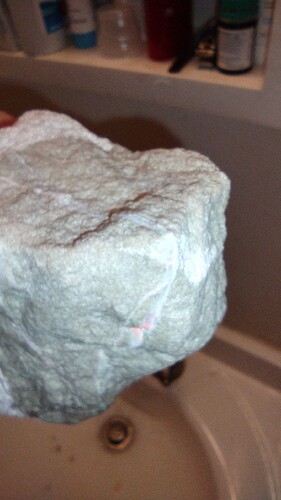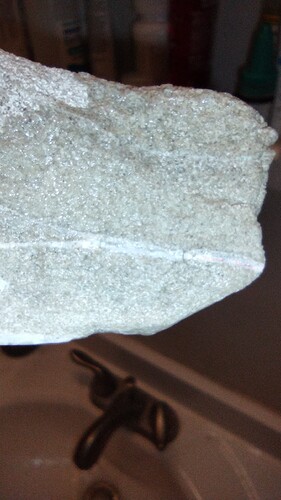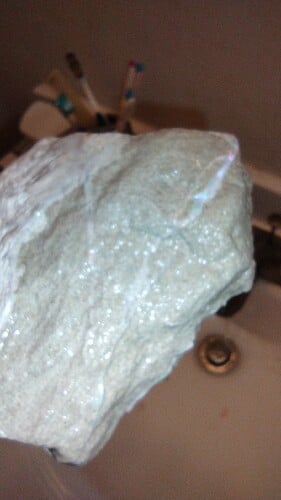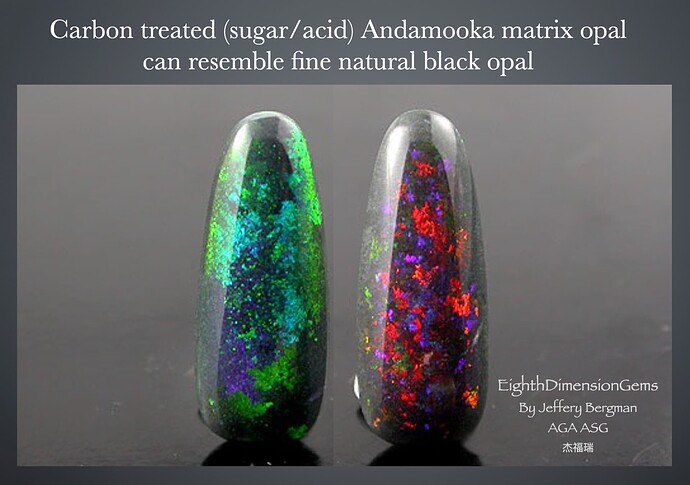I have this sandstone it has actual opal veins in it and I can see some matrixing throughout the sandstone it does not look like anamuka. the veins of opal are very thin and scarce I would like to treat it does anyone know what type of opal this would be considered? and if i treating it with the same process as animuka would it result in a decent looking stone?
In my opinion, I would not treat it. The opal is clearly seam opal and not the typical Andamooka matrix type opal, so treating with sugar and acid would not be the way to go. There are rare varieties where the opal is in quartz. Whether or not to cut it is up to you. Maybe consider carving some of the sandstone away and revealing some of the color, polishing the exposed color and leaving it as a specimen piece.
Agree with the above, not Andamooka… possibly White Cliffs type with the host rock being a type of quartz. Don’t treat!
I completely agree with both of you I knew it was not anamuka I have and I’m good and it’s not similar at all this is more like sands Stone and there’s only a couple very thin vains of actual opal if you can see them in the pictures and only a couple have any color but there’s a pretty decent matrix when I sanded the stone a little bit it was stronger and you can see it under a loop so I was hoping if I treated it after carving it or cutting it and polishing it “if it’ll even take the Polish it’s pretty grainy so it might not take a great polish in the state it’s in” images make the matrix a little more visible. I’ve never had a piece of opal or seen one that has so much sand and just a couple tiny veins throughout such a big rock what would you call this type of opal?
Hi and Happy Easter.
It’s definitely not worth treating it in any way as it is seam Opal. If you decide to cut it there may be further amounts of colour beneath the sandstone this is the beauty of Opal . You could cut a small section and slowly bring it down to the colour. Andamooka & Ethiopian matrix Opal are completely different from your piece and you would destroy it by trying to treat it.
I cut and polish Opal pieces really regularly and I have done some Andamooka matrix stuff using the sugar acid.
The piece you cut off ( if you decide to go that way ) when you get to some colour you like use Diamond pastes after shaping. Really does give the best results.
So you’re saying what I have is called seem opal? And if I sand it down and polish it and it has color I can’t treat it with the sugar acid like anamuka because you would ruin it in some way? So you’re suggesting just cutting it down to where the best color is in The matrix or attempt to get one of the seems to share decent color and just leave it like that after a Polish or is there another way to treat it that you know of?
Hi John B
As it’s sandstone its going to be destroyed using the sugar acid treatment.
If it was my piece I would cut a section that you can see a vein in and gently go down to it. See exactly what you have got as far as colour etc . Shape it and see what results you get.
Just don’t treat it as it will destroy the piece. Andamooka, Matrix Opal is completely different. I cook mine for around 7 days and then seal it after .
Seam Opal can give you some beautiful colours and when polished they look amazing.
Hope that helps
Sugar/acid treatment just creates a carbon coating on matrix that is very shallow hence people form the polished piece first before treatment. You really need a fairly chunky piece to start with otherwise you finish up with brittle small pieces. Your best bet is to use a diamond saw to expertly cut so that maximum opal surface is exposed to view. However, if your sandstone is crumbly I advise treating with sodium silicate solution and drying before cutting.
100% sure not Andamooka matrix which can be sugar/acid treated. I lived in South Australia for four years, visited Andamooka dozens of times, cut and treated thousands of carats of Andamooka matrix opal, and yours is not it.
Ivan thank you very much sir it seems very obvious to me that you completely understand the material that I am dealing with and that you’ve read the entire form because I have said more than once I have Anamuka and that this is absolutely not that I am very interested in using the method that you’re referring to I have heard of liquid glass although I’ve never used it I do understand most of the chemical properties of it but since I’ve never used it or even looked into it until I have read your comment.so thank you once again! I’ve already ordered some my understanding is it’s tiny particles of silica similar to silica sand but way smaller it’s used in concrete pottery things like that mostly as a hardening agent and mixed with water most of the time and then the H2O is evaporated off sometimes heated. My question for you sir how do you suggest I use it if you could please comment back with a written instruction and process I will definitely attempt to follow it. My understanding is that will do no harm to the opal or any changing of color it will just guarantee that the sandstone is in a better more solid state to be worked. So after the process of the water glass I will then work the piece trying to expose the vein hopefully on a visible side My Hope originally was to be able to carve it since it’s a large piece the reason I wanted to treat it was just to bring out the color of it I adding a little contrast since the veins are thin and there is a matrix I just assumed that if I treated it it may give it a little bit of contrast I know it’s not going to turn black and beautiful like animuka I was actually shooting for a very light treatment like you s
Hello John. The difficulty here is to keep the thin opal vein intact despite the fact that around it you have crumbly sandstone. I suggested sodium silicate but equally I could have suggested epoxy resin or vinyl acetate or acrylonitrile (instant glue) as agents that can permeate the sandstone and set in it thus ensuring stability whilst grinding and cutting etc. The choice of agent and its usefulness depends on the permeability ie porosity of the sandstone. High viscosity in the “glue” is not good if the porosity is low. Sodium silicate is traditional whereas the others are “high tech”. It’s really about experimentation. Epoxy is great but may not penetrate far enough and then you may have unwelcome residues on your opal. Instant glue sets too quickly but you can dilute it slightly with acetone (which is also useful for removing it later from opal after it sets). I wish you luck!
A lot of seam opal has changes in direction and thickness. If it looks too thin, you might consider making it into a doublet. Just make sure you pick the right side to glue on the backing.




